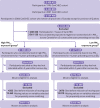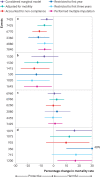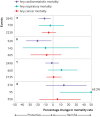Changes in exposure to ambient fine particulate matter after relocating and long term survival in Canada: quasi-experimental study
- PMID: 34625469
- PMCID: PMC8498990
- DOI: 10.1136/bmj.n2368
Changes in exposure to ambient fine particulate matter after relocating and long term survival in Canada: quasi-experimental study
Abstract
Objective: To investigate the association between changes in long term residential exposure to ambient fine particulate matter (PM2.5) and premature mortality in Canada.
Design: Population based quasi-experimental study.
Setting: Canada.
Participants: 663 100 respondents to the 1996, 2001, and 2006 Canadian censuses aged 25-89 years who had consistently lived in areas with either high or low PM2.5 levels over five years preceding census day and moved during the ensuing five years.
Interventions: Changes in long term exposure to PM2.5 arising from residential mobility.
Main outcome measures: The primary outcome was deaths from natural causes. Secondary outcomes were deaths from any cardiometabolic cause, any respiratory cause, and any cancer cause. All outcomes were obtained from the national vital statistics database.
Results: Using a propensity score matching technique with numerous personal, socioeconomic, health, and environment related covariates, each participant who moved to a different PM2.5 area was matched with up to three participants who moved within the same PM2.5 area. In the matched groups that moved from high to intermediate or low PM2.5 areas, residential mobility was associated with a decline in annual PM2.5 exposure from 10.6 μg/m3 to 7.4 and 5.0 μg/m3, respectively. Conversely, in the matched groups that moved from low to intermediate or high PM2.5 areas, annual PM2.5 increased from 4.6 μg/m3 to 6.7 and 9.2 μg/m3. Five years after moving, individuals who experienced a reduction in exposure to PM2.5 from high to intermediate levels showed a 6.8% (95% confidence interval 1.7% to 11.7%) reduction in mortality (2510 deaths in 56 025 v 4925 deaths in 101 960). A greater decline in mortality occurred among those exposed to a larger reduction in PM2.5. Increased mortality was found with exposure to PM2.5 from low to high levels, and to a lesser degree from low to intermediate levels. Furthermore, the decreases in PM2.5 exposure were most strongly associated with reductions in cardiometabolic deaths, whereas the increases in PM2.5 exposure were mostly related to respiratory deaths. No strong evidence was found for the changes in PM2.5 exposure with cancer related deaths.
Conclusions: In Canada, decreases in PM2.5 were associated with lower mortality, whereas increases in PM2.5 were associated with higher mortality. These results were observed at PM2.5 levels considerably lower than many other countries, providing support for continuously improving air quality.
© Author(s) (or their employer(s)) 2019. Re-use permitted under CC BY-NC. No commercial re-use. See rights and permissions. Published by BMJ.
Conflict of interest statement
Competing interests: All authors have completed the ICMJE uniform disclosure form at www.icmje.org/disclosure-of-interest/ and declare: support from funded by Health Canada for the submitted work; no financial relationships with any organisations that might have an interest in the submitted work in the previous three years; no other relationships or activities that could appear to have influenced the submitted work.
Figures



Comment in
-
Cut particulate air pollution, save lives.BMJ. 2021 Oct 20;375:n2561. doi: 10.1136/bmj.n2561. BMJ. 2021. PMID: 34670803 No abstract available.
References
MeSH terms
Substances
LinkOut - more resources
Full Text Sources
Other Literature Sources
Medical
